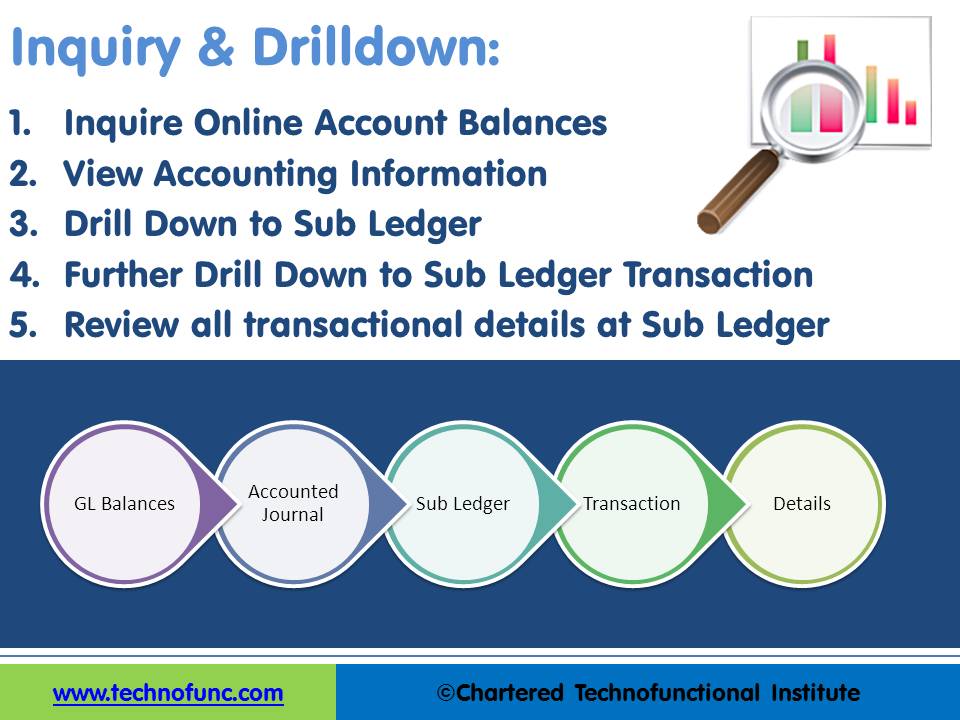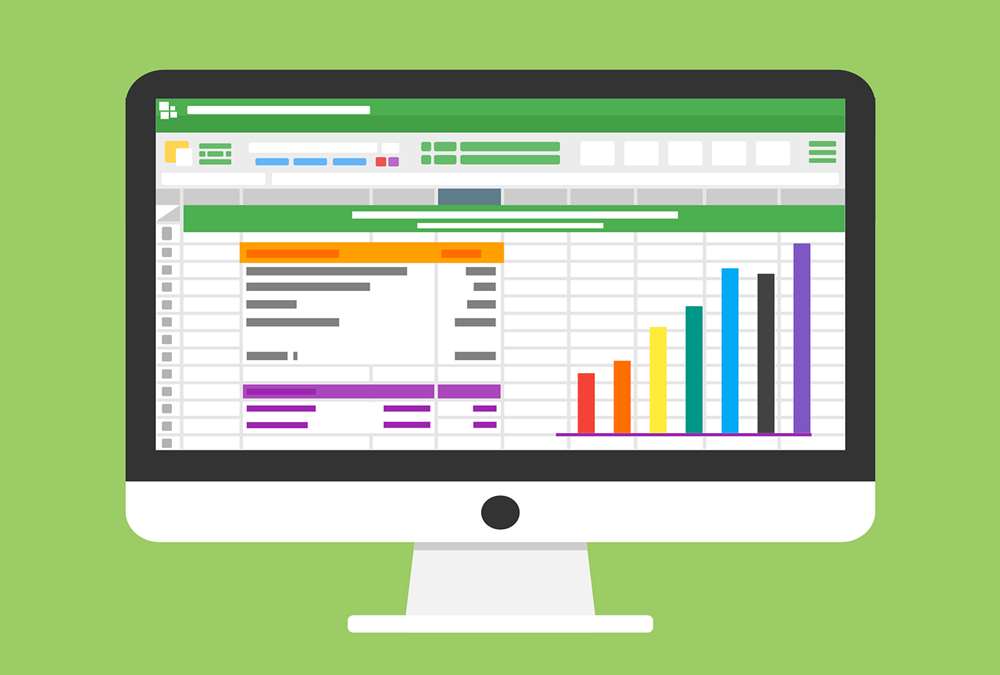- Home
- Business Processes
- Industry Knowledge
- Aerospace Industry
- Automotive Industry
- Banking Domain
- BFSI Industry
- Consumer/ FMCG Industry
- Chemicals Industry
- Engineering & Construction
- Energy Industry
- Education Domain
- Finance Domain
- Hospitality Domain
- Healthcare Industry
- Insurance Domain
- Retail Industry
- Travel and Tourism Domain
- Telecom Industry
- Leadership Skills
- eLearning
- Home
- Business Processes
- GL - Inquiry & Drilldown
GL - Inquiry & Drilldown
An account inquiry is a review of any type of financial account, whether it be a depository account or a credit account. In this tutorial, you learn what we mean by drill through functionality in the context of the general ledger system. We will explain the concept of drill-down and how it enables users to perform account and transaction inquiry at a granular level and the benefits of using this functionality.
What is Account Drilldown?
In information technology, to drill down means to move from summary information to detailed data by zooming in on something. In an ERP environment, "drilling-down" may involve clicking on some account balance or summary representation in order to reveal transactional data.
To drill down is to navigate through a series of steps, for example, the user starts with the summary balances that are made up of a group of accounts with individual balances, and drill down takes the user through the hierarchy to the individual account balances. The individual account balances are made up of transactions that have been posted in those accounts for a specified period and further drill down at this second level takes the user to the set of transactions. These steps of moving from summary balance to account balance belong to the general ledger system, however, the transactions might have originated from a subsidiary ledger. Further drill down at this level will take the user to a level of greater detail where the user can see the original transaction in the sub-ledger itself. Here in the drill-down process, the user is navigating from a higher level of consolidated information to a deeper level into data, without leaving the source system or changing user access.
When one drills down, one performs de facto data analysis on a parent attribute and inquiry of the detailed attributes that constitute the parent attribute. Drilling down provides a method of exploring multidimensional data by moving from one level of detail to the next. Drill-down levels depend on the data granularity and drill-down is a sub-function of inquiry and analysis. Drilldown functionality allows business users to gain better business insight to make critical decisions in order to beat out their competition.
Upstream & Downstream Systems:
Upstream Systems: In geography, upstream literally means towards the source of a stream or river, or against the normal direction of water flow. In the context of general ledger, upstream systems refer to the systems that send data to the general ledger system. In other words, upstream systems are subsidiary ledgers and other source systems that are capturing the transactional data and sending the accounting data to the general ledger for further processing.
Downstream Systems: Similarly, in geography, downstream literally means away from the source of a stream or river, or in the normal direction of water flow. In the context of the general ledger system, downstream systems refer to the systems that take data from the general ledger as their input. Some examples are consolidation systems, enterprise performance management systems (EPM), reconciliation systems, or business intelligence systems. The financial data from the general ledger are carried over as input for these downstream systems for further processing.

Drilldown from General Ledger to Upstream Systems:
In the advances general ledger systems, users can drill down to sub-ledgers details from General Ledger and can get all of the transaction details that comprise an account balance, regardless of which sub-ledger originated the transaction. This functionality helps in analyzing any account balance by understanding the source of the transaction and viewing additional information that has been captured in the source system and not imported into the general ledger system.
Drilldown from Downstream Systems to General Ledger:
Many advanced EPM or Consolidation downstream systems provides the users with the capability to drill down from their system to underlying Enterprise Resource Planning (ERP) transaction data. Some examples with the ability to drill down from Enterprise Performance Management (EPM) applications are Oracle Hyperion Financial Management System and Oracle Hyperion Planning. An example of a consolidation system is Oracle Financial Consolidation Hub. These systems allow the user to drill down from consolidated information to the related general ledger system. This provides users with greater visibility into business processes and a greater understanding of the consolidated data.
For most organizations, the basis for global financial consolidation, reporting and analysis, planning, budgeting, and forecasting are derived from a company's existing operational information which is generally stored in many different general ledgers like Oracle, SAP, PeopleSoft, or JD Edwards systems and drill down allows the user to see the actual data in the various general ledgers that constitute the data in these systems.
Drilldown within General Ledger System:
There are various drill-downs that are available in the general ledger system. We will briefly explain each one of them:
1. Interactive Report:
A Drill-Down Report is also called an Interactive Report and has more detail and capability to analyze and inquire data at a granular level. For example, the user is looking at the Balance Sheet Report with drill-down functionalities. The top-level information contains consolidated balances for a group of accounts such as current assets, fixed assets, etc. The drill-down functionality helps the user to select a line item (e.g., fixed assets) and drill-down further to a detailed list (secondary list) which displays various components of the fixed assets such as land, buildings, machinery, etc.
2. Summary Balances:
Some general ledgers provide the functionality to maintain summary accounts that contain consolidated balance for the group of accounts clubbed under that summary account. Users may drill-down to individual group accounts by using the drill-down functionality.
3. Account Balances:
Drilling down on balances in the general ledger may take the user to line level transactions constituting those balances.
4. Account Transactions:
Drilling down on balances will take the user to the journal where the transaction has been captured in the source system.
You May Also Like
-
For any company that has a large number of transactions, putting all the details in the general ledger is not feasible. Hence it needs to be supported by one or more subsidiary ledgers that provide details for accounts in the general ledger. Understand the concept of the subsidiary ledgers and control accounts.
-
Horizontal or Flat Organizational Structures
Flat organizational structure is an organizational model with relatively few or no levels of middle management between the executives and the frontline employees. Its goal is to have as little hierarchy as possible between management and staff level employees. In a flat organizational structure, employees have increased involvement in the decision-making process.
-
Legal Structures in Businesses
Businesses not only vary in size and industry but also in their ownership. Most businesses evolve from being owned by just one person to a small group of people and eventually being managed by a large numbers of shareholders. Different ownership structures overlap with different legal forms that a business can take. A business’s legal and ownership structure determines many of its legal responsibilities.
-
Funds contributed by owners in any business are different from all other types of funds. Equity is the residual value of the business enterprise that belongs to the owners or shareholders. The funds contributed by outsiders other than owners that are payable to them in the future. Liabilities are generally classified as Short Term (Current) and Long Term Liabilities. Current liabilities are debts payable within one year.
-
Hierarchical Organization Structures
Hierarchical structure is typical for larger businesses and organizations. It relies on having different levels of authority with a chain of command connecting multiple management levels within the organization. The decision-making process is typically formal and flows from the top down.
-
In this article, we explain some commonly used subsidiary ledgers like accounts receivable subsidiary ledger, accounts payable subsidiary ledger or creditors' subsidiary ledger, inventory subsidiary ledger, fixed assets subsidiary ledger, projects subsidiary ledger, work in progress subsidiary ledger, and cash receipts or payments subsidiary ledger.
-
In some of the ERP tools, there are more than 12 accounting periods in a financial year. This article discusses the concept of accounting calendar and accounting periods. Learn why different companies have different accounting periods. Understand some of the commonly used periods across different organizations and the definition & use of an adjustment period.
-
Reversing Journals are special journals that are automatically reversed after a specified date. A reversing entry is a journal entry to “undo” an adjusting entry. When you create a reversing journal entry it nullifies the accounting impact of the original entry. Reversing entries make it easier to record subsequent transactions by eliminating the need for certain compound entries. See an example of reversing journal entry!
-
Generally Accepted Accounting Principles define the accounting procedures, and understanding them is essential to producing accurate and meaningful records. In this article we emphasize on accounting principles and concepts so that the learner can understand the “why” of accounting which will help you gain an understanding of the full significance of accounting.
-
There are five types of core accounts to capture any accounting transaction. Apart from these fundamental accounts, some other special-purpose accounts are used to ensure the integrity of financial transactions. Some examples of such accounts are clearing accounts, suspense accounts, contra accounts, and intercompany accounts. Understand the importance and usage of these accounts.
Explore Our Free Training Articles or
Sign Up to Start With Our eLearning Courses

About Us
Learning
© 2023 TechnoFunc, All Rights Reserved










